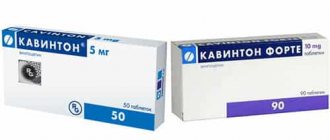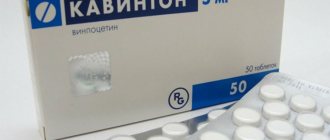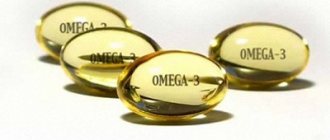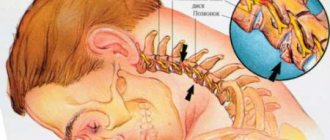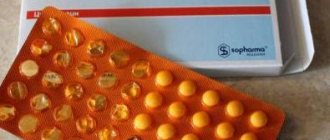As a person ages, he or she experiences many unpleasant symptoms, one of which is dizziness. Dizziness (Latin – vertigo) – loss of body orientation in space. Unfortunately, no person is able to resist the changes in our body that occur along with the aging process, and treating dizziness in older people becomes more important even than a cold or flu. And the younger generation often faces this problem. More and more often, among other complaints, doctors hear: severe dizziness.
Let's figure out what the symptoms of dizziness are, what is the cause of this disease, and how to get rid of it.
Causes
The function of maintaining balance is provided by the vestibular apparatus, which is located in the petrous part of the temporal bone and in its structure resembles a labyrinth. Most often, it is disruptions in the functioning of this apparatus that cause dizziness in the elderly. The causes of these failures are poor blood supply to the labyrinth due to changes in blood properties, atherosclerotic plaques, and microthrombi. It is these problems in the body that cause these symptoms. Dizziness in this case is associated only with local disturbances in the operation of the apparatus and is characterized as peripheral. There is also a central one - in this case, attacks of dizziness are associated with brain damage, for example, if there are tumors or strokes.
What can replace the drug?
Among the medicines, there are quite a lot of analogues of this drug. But replacing Cavinton with VSD with a drug similar in indications for use is allowed only on the recommendation of the attending physician.
This need usually arises when this drug is not on sale or when looking for a cheaper option.
The choice or prescription of such a drug by the attending physician is based on the main active ingredient Cavinton for VSD.
Similar drugs include: Vinpocetine, Bellataminal, Pantocrine Pantea Evalar, Doppelhertz Active, Dormiplant, Neuromultivit, Neocardil, Sonapax.
The cost of Cavinton for VSD can vary within a different range. This is due to the place where the drug is sold, the company selling it and other various market nuances.
The average price in various Cavinton pharmacy chains for VSD is:
- from one hundred fifty to one hundred ninety rubles for a pack of Cavinton tablets of fifty pieces;
- from two hundred twenty to two hundred seventy rubles for a pack of Cavinton Forte tablets of thirty pieces;
- from five hundred and sixty to six hundred and ten rubles for a pack of Cavinton Forte tablets of ninety pieces;
- the price for the drug in ampoules ranges from two hundred and fifty to three hundred and forty rubles.
With VSD, high blood pressure is quite often observed. Cavinton lowers arterial pressure with VSD. Increases the resistance of the brain and the entire body to the influence of negative factors.
What kind of medicine is this
Drug group
Compound
Indications
Release forms
Side effect
Contraindications
Use in children
Use in the elderly
Do I need a prescription?
Systemic and non-systemic dizziness
Systemic and non-systemic dizziness are also distinguished.
- Non-systemic dizziness is caused by neurogenic disorders, including stress, fatigue, various somatic diseases - arterial hypertension, diabetes mellitus. At the same time, sometimes my vision becomes dark and I feel dizzy.
- Systemic vertigo is associated with a malfunction in one of the systems of the vestibular apparatus, for example, the visual analyzer, and is felt as movement of the body in space, the movement of objects.
Severe dizziness can cause basic hunger. This is a separate situation. In this case, drug treatment for dizziness in older people is not required.
Benign paroxysmal positional vertigo
Why does it happen? This type of vestibular vertigo is due to the fact that, for various reasons (as a result of injury, lack of vitamin D, prolonged bed rest), microscopic crystals - otoliths, located in one part of the vestibular analyzer, fall into another, thereby causing attacks of severe dizziness, provoked changing head position.
How it manifests itself. Unlike young and middle-aged people, in an elderly person, benign paroxysmal positional vertigo can only manifest itself in a feeling of instability and loss of balance when walking.
How to treat it. Using a special procedure, during which an experienced otoneurologist, changing the position of the patient’s head in a certain sequence, helps return the otoliths to their original place.
Ailments accompanied by dizziness
- Ear diseases – acute and chronic otitis media, otosclerosis.
- Migraine – dark vision and dizziness an hour before the attack.
- Diseases of the cerebellum - tumors, degeneration of the structure.
- Neurological diseases - multiple sclerosis, Parkinson's disease.
- Oncological diseases of the brain - attacks develop gradually and intensify with a change in head tilt.
- Damage to the cervical spine - trauma, deforming ostosis.
- Seasickness.
- Neuropsychiatric disorders.
- Meniere's disease - the patient not only feels dizzy and weak, but also experiences tinnitus and vomiting.
- Cervical osteochondrosis - darkening of the eyes and dizziness with sudden movements in the cervical region, pain and limited movement are felt.
- Prelymphatic fistula - characterized by hearing loss, tinnitus, nausea, vomiting, dizziness.
- Darkness in the eyes and dizziness are a common symptom of vertebrobasilar insufficiency. This disease occurs with atherosclerotic damage to large vessels, hypertension and dyscirculatory encephalopathy - very common “companions” of older people.
- Severe dizziness develops with acute disorders of cerebral blood supply - ischemic or hemorrhagic stroke of the brain stem and cerebellum. But that is not all. With neurological disorders, not only does the head become very dizzy, but other neurological symptoms also appear - tinnitus, spots in front of the eyes, nausea, vomiting, so treatment should begin with a complete collection of all symptoms.
- Pathological changes in the eye muscles - with frequent changes in the picture before the eyes, the muscular system does not have time to focus.
Instructions for use
The use of Cavinton for osteochondrosis requires prior consultation with the attending physician. The drug is usually well tolerated, with most patients reporting an improvement in their condition.
Is Jamaldinov’s set of exercises effective for joints?
Find out from this article how to make a machine to strengthen the muscles of the back and spine.
Compound
Cavinton is available in tablets and ampoules for injection. The active ingredient of the drug is vinpocetine.
Tablets may contain 5 and 10 mg of the active ingredient. In addition, the product contains excipients - talc, starch, lactose. Packages are available in 30, 50 and 90 tablets.
Ampoules can contain 2, 5 and 10 ml of vinpocetine. 1 package of the drug consists of 5 or 10 injection forms.
Mechanism of action
Cavinton enhances cerebral circulation and stimulates the metabolism of the central nervous system. The drug has a neuroprotective effect on cellular structures by reducing the severity of cytotoxic reactions in tissues. Cavinton stimulates the uptake of glucose by brain cells.
The drug improves blood flow and reduces its viscosity. The drug has a powerful antioxidant effect. These mechanisms can effectively reduce the severity of symptoms in cervical osteochondrosis.
Contraindications
The drug is not used in the following situations:
- The presence of hypersensitivity to its components.
- Patients are under 18 years of age.
- Pregnancy and lactation.
- Severe form of coronary heart disease.
- Hemorrhagic stroke in the acute phase.
- Severe arrhythmias.
It is important to be careful for people with lactose intolerance, since it is part of the tablet forms of the drug.
Side effects
When using Cavinton for osteochondrosis of the cervical spine, patients may be concerned about the following side effects: the appearance of allergic reactions in the form of hyperemia of the skin and rash, complaints of general weakness, headaches and dizziness, sleep disturbances, increased sweating.
How to use
The drug should be prescribed only by a doctor who determines the treatment regimen and, if necessary, corrects it. The usual dosage of Cavinton is 1-2 tablets three times a day after meals. Treatment begins with a daily dose of 15 mg. Further tactics depend on the dynamics of the disease. The course of therapy can be long - from 1 to 8 months.
As for the liquid form, it is intended for intravenous administration only. A certain amount of medication (the volume is calculated relative to the patient’s body weight) is diluted in 200 ml of saline, followed by a slow infusion of the drug. The average course of application is 2 weeks.
Medicines that cause dizziness
The list of drugs that have dizziness as a side effect is endless. These include:
- analgesics (painkillers);
- antianginal drugs;
- antihypertensive;
- beta blockers;
- diuretics;
- cardiac glycosides;
- antibiotics;
- non-steroidal anti-inflammatory drugs;
- antidepressants;
- tranquilizers;
- sleeping pills;
- anticonvulsants;
- A number of aminoglycoside antibiotics - Streptomycin, Kanamycin, Neomycin - are particularly toxic.
History taking and external examination
At the very beginning of the examination, it is necessary to identify the very fact of dizziness. Elderly patients tend to mistake one symptom for another, and the concept of dizziness is given a different meaning - nausea, blurred vision.
The neurological examination of the patient itself is of great importance - pay attention to the precise fulfillment of coordination tasks, determine the state of reflexes. It is necessary to find out the nature of the development of the disease, the factors that provoke it. For example, a slow, gradual onset is more typical for dizziness of central origin, while spontaneous and rapid onset is more typical for dizziness of peripheral origin. Local disorders (tinnitus, hearing loss) are characteristic of peripheral vertigo, and symptoms of damage to the cortex and brain stem are characteristic of central vertigo. Severe repeated vomiting without relief indicates vestibular pathological processes.
Diagnosis is carried out in various body positions, this can also say a lot, for example, they ask the patient to lower his head to the side. If, when changing the position of the head, there is an increase or sudden onset of dizziness, this indicates that disturbances most likely have arisen in the functioning of the vestibular apparatus, and they are benign in nature.
The patient is asked about all previous inflammatory and autoimmune diseases, intoxications (medicinal, alcoholic), and head injuries. During a neurological examination, great attention is paid to nystagmus.
Nystagmus is involuntary high-frequency vibrations of the eyeballs. Spontaneous nystagmus is checked - when looking straight ahead, then when moving it to the side (gaze-induced nystagmus). The Hallpike test is performed - the patient sits on the couch with his eyes open, his head turned 45 degrees to the right. Supporting the patient by the shoulders, he is asked to quickly lower himself onto his back so that his head hangs freely over the edge of the couch. Then the same is done with the head turned in the other direction, that is, to the left.
An ENT examination consists of examining the external auditory canal, eardrum, identifying wax plugs, acute and chronic infections, and traces of trauma.
“Cavinton is a drug for improving cerebral circulation”
Lesser periwinkle is an attractive plant with dark green leathery leaves and purple flowers. It covers entire meadows and forest edges and looks very picturesque. No wonder Jean-Jacques Rousseau called it his favorite flower. It was from this plant that the alkaloid vincamine was isolated, from which Hungarian pharmacologists obtained vinpocetine in 1975.
Since 1978, the pharmaceutical company A. O. Gedeon Richter has marketed vinpocetine under the name Cavinton. The drug is loved in Russia and Eastern European countries, and is classified as a nootropic and vascular drug.
Active ingredient: Cavinton
Cavinton tablets and ampoules, photo
Alkaloids always have a complex effect. And vinpocetine in experiments showed the ability to improve blood microcirculation, dilate blood vessels, and reduce platelet aggregation.
The drug affects the smooth muscles of the brain vessels - arteries and arterioles.
By dilating blood vessels, Cavinton helps increase blood flow in those areas of the brain where it is insufficient due to the presence of vascular spasm.
In patients with chronic vascular diseases of the brain (for example, cerebral atherosclerosis), the drug improves cerebral blood flow, the structure of the vascular endothelium, and in scientific studies with MRI angiography it was shown that Cavinton selectively increased cerebral blood flow in those areas. where it was violated.
The use of Cavinton tablets helps ensure that more oxygen and glucose enters the brain cells - the resistance of brain tissue to hypoxia increases.
Glucose metabolism in the brain becomes more economical. At the same time, the drug is able to stimulate the noradrenergic part of the neurotransmitter system of the brain, and does not have a “stealing” effect. Thus, Cavinton is indicated primarily for patients with the development of ischemic strokes (cerebral infarctions).
Does it work or not?
Currently, the concept of evidence-based medicine is recognized in the world, according to which any effect of a drug must be proven mathematically, in the language of medical statistics.
There is an insufficient evidence base for Vinpocetine and Cavinton, and therefore in the USA it is recommended only as a food additive, and since 2007 in the Russian Federation it has been recognized as an “outdated drug with unproven effectiveness.”
The fact is that only endpoints that can be “calculated” are significant - for example, the life expectancy of patients taking the drug and not taking it.
Indeed, such large-scale studies have not been conducted, but doctors like the effect of the drug, just like patients, and Cavinton (more precisely, vinpocetine) is included in the list of vital and essential medicines.
After all, if you look at it more broadly, a huge number of drugs will not “pass the filter” of evidence-based medicine. For example, our favorite green stuff is practically not used abroad.
And not only because it makes the patient unaesthetic, but also because there is no data on follow-up - what if, many years after use, it increases the incidence of malignant neoplasms? In the West, nootropic drugs, vitamins, hepatoprotectors, and many other drugs that are considered almost mandatory in our country are not used.
Cavinton - indications for use
Why does Cavinton help? The indications for the use of this drug are wide, but it is most effective for vascular lesions of the brain. The most common indications include:
- acute cerebral circulatory failure (cerebral infarction, ischemic stroke);
- recovery period of various forms of hemorrhagic stroke;
- transient ischemic attack;
- migraine;
- encephalopathy (hypertensive and post-traumatic);
- chronic vertebrobasilar insufficiency;
- various types of vascular dementia;
- thrombotic vascular conditions in ophthalmology;
- for the treatment of vestibular disorders (dizziness, Meniere's disease);
- cerebral atherosclerosis.
You may get the impression that Cavinton is a medicine for the elderly. But this is not so: there is evidence of the successful use of the drug for concussions in young people.
How to take the drug?
"Cavinton" is available both in tablets and in injection form. The tablets contain 5 mg of the drug, and you need to take 1 - 2 tablets after meals, but not more than 30 mg per day, that is, 6 tablets. Then, for ease of administration, the Cavinton Forte form was created, where each tablet contained 10 mg of the drug, since taking 10 mg after meals is most effective.
And in recent years, Cavinton - Comfort has appeared. There is no difference in action: they also contain 10 mg of vinpocetine, but the form has changed. Now these are dispersible tablets with an orange flavor that can be dissolved or dissolved in water. The duration of the course of taking the drug is about two weeks.
The use of Cavinton “injections” is more justified for strokes, encephalopathies and severe dementia, with then a transition to tablet forms. Injections are administered intravenously slowly, each ampoule contains 2 ml, each ml contains 5 mg of the drug. Thus, one ampoule is equivalent to one Cavintona Forte tablet.
It is important that you cannot inject just the contents of the ampoule intravenously: you need to dilute it in an isotonic solution of sodium chloride and drip it. The rate of administration of drops should not exceed 60 - 80 per minute.
Is it possible to administer Cavinton intramuscularly? It is forbidden. This is strictly prohibited.
Start the infusion of the drug by adding 2 ampoules (20 mg) to 0.4 liters of isotonic solution, then increasing to 5 ampoules per duck (50 mg). The course of treatment is 10–14 days. Cavinton injections must be administered slowly to avoid heart rhythm disturbances.
Side effect
Usually the drug is well tolerated. The use of Cavinton Forte at a dose of 10 mg also does not lead to the development of effects, even if you take 60 mg per day for a long time, that is, a double dose. But sometimes the following side effects still develop:
- various sleep disorders (from drowsiness to insomnia);
- heartburn, dry mouth, attacks of nausea;
- general weakness and headache;
- lowering blood pressure;
- sweating
A complete list of side effects and contraindications can be found in the official instructions.
Analogues and generics of Cavinton, list
Reviews of analogues that have a lower price and identical instructions for use as Cavinton are contradictory. Everything depends on the quality of the substance used. It is known that Cavinton is the first and original vinpocetine.
Therefore, when saying which is better - Cavinton or Vinpocetine, you need to understand that they are one and the same thing.
Only “Cavinton” is, of course, the highest quality vinpocetine available on the market, with a production scheme proven over decades, high quality of the starting substance and production control at all stages of production.
There are a lot of analogues of Cavinton: after all, it is a very popular drug. In pharmacies you can, for example, purchase the following products:
- Bravinton;
- Vinpocetine – ACRI;
- Vincetin;
- Vinpocetine – SZ;
- Korsavin;
- Telektol.
All these drugs have different quality of substance. But, unlike the original drug, where the substance is prepared directly at the enterprise, many domestic pharmaceutical companies simply purchase it abroad.
Most often, the country in which the substance is produced is India or China. Accordingly, at domestic pharmaceutical enterprises only the production of tablets and packaging occurs. This allows you to significantly reduce the price.
On the other hand, firms do not invest in their own chemical production, which allows them to initially save many millions of dollars.
Now you know what you can replace Cavinton with. But, before you do this, think about the fact that the price of Cavinton is not at all exorbitant, while its quality is certainly the best of all vinpocetine preparations presented on the modern Russian market.
is not only the manufacturer of this drug since 1978, but also the creator of the drug. And this, you see, means a lot for quality and reputation on the world market.
atherosclerosis stroke migraine drugs
Source: https://zdorova-krasiva.com/kavinton-preparat-dlya-uluchsheniya-mozgovogo-krovoobrashheniya/
Laboratory and instrumental diagnostics
CT and MRI are performed to exclude neoplasms and demyelinating processes, and attention is paid to the presence of structural changes, congenital or acquired. If there is a suspicion of new or old fractures, x-rays of the skull bones are performed.
If there are suspicions of vascular disorders, they are referred for Doppler ultrasound of the great vessels of the head and neck.
A general blood test is performed to exclude infectious processes; if a pathogen is identified, antibodies to it are determined.
Pure-tone audiometry is performed if the patient has concomitant hearing impairment. The subject is offered to drink “Glycerol,” which allows one to detect improved perception of low frequencies and improves speech perception. If this symptom is positive, then this indicates Meniere's disease, a common symptom of which is attacks of dizziness.
Dizziness, which is combined with hypochondria, apathy, groundless painful sensations, and decreased mental abilities, indicates the presence of a neurological or psychiatric disease.
Meniere's disease
Why does it happen? This chronic disease of the inner ear leads to an increase in the amount of fluid in its cavity, paroxysmal dizziness and progressive hearing loss.
How it manifests itself. Attacks of rotational vertigo, the frequency of which in elderly patients decreases as hearing deteriorates. But instability often becomes almost constant.
How to treat it. In most cases - with medications. If these do not help, a labyrinthectomy is an option, a procedure in which the affected vestibular apparatus of the inner ear is removed or “disabled.” After this, the patient must undergo a course of vestibular rehabilitation (a special version of vestibular gymnastics).
Dizziness in old age. Treatment
Drug therapy is prescribed by a specialist after a full examination and based on factors that were identified during the examination of the patient. It completely depends on the cause that caused this illness. Treatment of dizziness in older people is a labor-intensive process.
An important role is played by the prescription of drugs that tonify the vascular bed and prevent the occurrence of ischemia of the labyrinth, improving the trophism and metabolism of tissues (Cavinton, Memoplant, Sermion). "Vasobral" improves blood circulation in the brain, reduces the permeability of vascular walls and increases the resistance of brain tissue to lack of oxygen. You should be careful when choosing medications for dizziness in old age.
Among modern drugs, the most effective are considered to be drugs based on betagestin dihydrochloride. These include medications “Betaserc”, “Betavirin”, “Vestibo”, “Tagista”. But they will be ineffective if they are not prescribed together with drugs that affect the identified mechanisms of the development of dizziness and balance disorders. Among the commonly prescribed medications are medications for the treatment of depressive and anxiety disorders.
Doctors select symptomatic therapy that is aimed at correcting existing somatic, orthopedic or neurological pathologies that contribute to the development of dizziness. So, for example, levodopa drugs are used to treat Parkinson’s disease; if atrial fibrillation is detected, the patient needs to take appropriate antiarrhythmic drugs; if oncological processes are detected, the patient is sent to an oncologist for further examination and treatment in the appropriate oncology department.
If the patient’s condition allows and no gross disturbances in the functioning of the body have been identified, it is very useful to engage in therapeutic exercises, walks in the fresh air should be done more often if possible, and most importantly, monitor whether symptoms have reappeared. Dizziness may return.
Cavinton helps with headaches
Recommend medications for headaches
Headaches for 5 years. At first I took analgin, for the last three years I switched to paracetamol. (I don’t take aspirin - it makes my stomach hurt, ibuprofen doesn’t help much). The problem is that headaches are very frequent, and I drink a lot of paracetamol in my life. I've already drunk a LOT of it in my life. I am afraid that it has harm to the body and will soon accumulate.
Cavinton also helps with headaches. But here’s the situation: a year ago, as prescribed by a neurologist, I started drinking Cavinton, and in total I drank three tablets (blister packs) (Cavinton 10 mg). for about 2 months. I didn’t take it as a course, but when I have a headache (like a pain reliever), it acts quickly and then the effect wears off.
The neurologist said that you can take it (not as a course, but as needed). But it seems to me that after it, the headaches became more frequent and stronger. That is, in the last year the pain intensity has increased, but perhaps this is not due to Cavinton. Now I decided to check it out, and also do a period with Cavinton.
But you can’t take it endlessly, permanently, for years.
It seems to me that it is even more harmful than paracetamol.
Viburnum berry also helps with headaches - quickly, but weakly, in order to feel its help you need to eat it in plates - this is a little unrealistic.
I am worried about the large number of analgesics I have consumed in my life (mostly paracetamol), and the fact that there is nothing to replace them with, and it is very difficult to endure such pain, sometimes unbearable. Question: What can I replace paracetamol and Cavinton with? Please advise what to take for headaches, preferably the least harmful one.
Recommend several medications. And pharmaceutical drugs and maybe also dietary supplements, or folk herbs (herbs so that you can buy them ready-made in pharmacies). Just a few, because some of the drugs may be eliminated due to side effects or ineffectiveness.
I wrote a description of the headache below based on the questionnaire from your forum.
The cause of the pain is a nervous disease (residual organic damage to the central nervous system), which doctors have not been able to cure for many years. At the moment I have several untried drugs left (with a low probability that they will help). I'm currently collecting money for them. If they don’t help, then it’s a dead end, I’ll get disability.
1) Gender, age, weight. husband. 30, 62 2) The nature of your work? mental 3) When did you first start noticing headaches? 5 years ago 4) Has the nature of your headaches changed recently (are the pains more frequent? stronger? have they become different?)
Getting stronger every year
5) At what time of day do you usually notice a headache? more often in the evening, in the last year - increasingly happens at any time and in the morning
6) The nature of the headache is pressing
7) Localization of headache - whole head, migrating


9) How long does a headache attack last? Hours, days, more
10) How often do headache attacks occur? Maybe every day, maybe a period of a week or two without pain, maybe every day. On average, if you add up all the hours in a month, you have a headache for one fifth or sixth of your life.
11) What causes a headache attack? There is some dependence on the weather (after a headache attack, the weather often changes sharply), if I drive a car, the likelihood of pain increases, and also due to a disturbance in the rhythm of sleep, for example, if I get up late.
But it often happens for no reason at all.
12) Is the headache accompanied by nausea and vomiting? When it hurts a lot, it makes you feel a little nauseous
13) Is the headache accompanied by fear of light and/or sound? Visual impairment? no 14) Is the headache accompanied by lacrimation, runny nose, or redness of the eyes? no 15) Is headache accompanied by limitation of daily activities?
Yes
16) What is the intensity of pain on a 10-point scale? Sometimes it’s background, it’s tolerable, sometimes it’s very strong that I’m dying
17) How does a headache stop? Does not stop, but partially reduces: paracetamol, aspirin, analgin, Cavinton, viburnum berries.
18) How often do you take painkillers? Which? At what dose? Very often, for the first two years I took analgin, then I found out that paracetamol is less harmful, for the last 3 years I have been taking paracetamol. On the day when I have a headache I take 1 to 2 tablets.
Depending on the severity of the pain, often even two tablets of paracetamol + 10 mg. Cavinton - do not help completely relieve pain. Sometimes the pain is so severe that 2 tablets. paracetamol + 10 mg. Cavinton, but the pain is still very strong.
At such moments, without the pills the pain would be simply unbearable.
19) Is there a connection between headaches and pain and/or limited mobility in the cervical spine? no 20) Is there a connection between headaches and blood pressure levels?
My blood pressure is a little high, 140/90. But there is no direct correlation between headaches and blood pressure, I checked. And blood pressure medications do not help with headaches.
21) Does the headache change when you change the position of your head/body? Worsened by shaking: walking, especially driving.
22) Do your relatives experience similar attacks of headaches? No
23) Have you had any head and/or neck injuries? No
Dr.Vad - that is, passing tests is not a guarantee of help. But increasing the chances that the doctor will answer.
Beck Self-Rating Depression Severity Inventory Hospital Self-Rating Depression and Anxiety Severity Scale Panic Attack Questionnaire Emotional Agitability Scale
Individual typological questionnaire
I can’t answer some questions, so the test is not completed.
In general, I cannot answer many psychological questions. They are so abstract. I can’t answer about 20% For example: Am I an emotional person?
-Well, how can I say – with friends, yes, at work, no.
When I get scared, I panic. – any person will panic, depending on how you scare
It's hard to scare me. -you can scare me easily or hard, depending on what
Compared to other people, I cope with failures more easily. – did not conduct a survey among others
I feel tense, I feel uneasy – what does uneasy mean?
I have a very complex and difficult character for others. – I don’t know, I didn’t ask others
When solving serious problems, I usually manage without outside help. – depending on what the problem is, it happens in different ways, both with and without help
If necessary, I will destroy all obstacles on the way to achieving my goal. – goals can be different and have different values and labor costs for them, obstacles also come in different densities, some are insurmountable, some are surmountable
In general, there are many questions that I cannot answer. 20% percent
Well, I can't answer. I could point out something out of the blue, but that would be wrong, there is no point in distorted results.
Toronto alexithymic scale – the result is within the normal range.
How to take Cavinton for headaches?
Cavinton is a unique drug from the group of nootropics that has a significant positive effect on the blood supply to the brain.
It promotes faster and more efficient uptake of glucose and other energy substrates by neurons, which allows the entire brain to work better, even under conditions of hypoxia and other damaging factors.
The active ingredient in Cavinton is Vinpocetine.
Indications for use of Cavinton
Cavinton is very widely used in neurological and psychiatric practice in various categories of patients. However, it is worth noting that you should not self-medicate with this drug. It is imperative to consult your doctor if symptoms of brain dysfunction appear.
Cavinton is prescribed in the following situations:
- Neurological deficit after damage to brain structures during the development of various diseases (traumatic brain injury, ischemic stroke, etc.).
- Transient ischemic attacks.
- Vascular form of dementia due to atherosclerosis, diabetes mellitus and other diseases.
- Insufficient blood supply to the brain due to pathology of the carotid or vertebral arteries.
- Encephalopathies developing against the background of cerebral vascular damage.
- A number of diseases of the blood vessels of the eye or inner ear.
In children and adolescents, Cavinton can be prescribed for any manifestations of brain dysfunction. Especially often, it is prescribed for memory and attention disorders in children. In addition, the appointment of Cavinton for dizziness of various causes is possible at any age.
When taking Cavinton, there are also contraindications:
- intolerance to individual components of the drug;
- severe forms of cardiovascular diseases;
- pregnancy, lactation and children under 3 years of age - data on the safety of Cavinton in these groups of people have not been obtained;
- established diagnosis of hemorrhagic stroke or suspicion of it.
Methods of using Cavinton
How to take Cavinton? The drug is available in two dosage forms: in the form of tablets and in the form of solutions for intravenous infusion. Treatment is divided into two stages: initial and maintenance.
The initial period of therapy is carried out immediately after exposure of the brain to a damaging factor (stroke, traumatic brain injury, etc.). In this case, intravenous administration of Cavinton 25 mg once a day is indicated.
To dilute the drug, either saline solution or a weak glucose solution with a volume of 500-1000 ml is used. After several days of taking Cavinton like this, they switch to maintenance treatment. During this phase of therapy, the total daily dosage of the drug is reduced to 15 mg.
At the same time, it is possible to switch to tablet forms of the drug - one tablet (5 mg) three times a day.
As a rule, Cavinton is taken in courses of 1-2 weeks. After this, the drug is discontinued. If there is a need for a repeat course, then a period of rest from the medication is required for 2-3 weeks. Cavinton for headaches and other minor neurological problems is immediately prescribed in the form of tablets for three doses of 5 mg.
How should children drink Cavinton? The use of the drug is possible from the age of three. The drug is prescribed 2.5 mg 3 times a day. The drug is discontinued when the required therapeutic effect is achieved.
Side effects of treatment
Side effects of Cavinton occur very rarely. It is possible to develop allergic reactions in the form of itching or urticaria, dizziness, general weakness and drowsiness. A number of patients experience a decrease in blood pressure and redness of the skin in the face and torso.
Advice! If these side effects occur, you should contact your doctor to adjust the dose and frequency of taking the drug.
Many doctors and patients ask the question, what can replace Cavinton? There are several analogues of this drug on the pharmaceutical market, the main one of which is Vinpocetine, which is also included in the described drug. Vinpocetine is no different in its effectiveness from Cavinton, but its cost is lower.
Cavinton is widely used in people with neurological disorders. Very often, this also happens in the form of self-medication, however, such an approach is not acceptable in the case of such serious diseases. Prescribing the drug and monitoring the effectiveness of therapy should occur under the supervision of a neurologist.
Source: https://headnothurt.ru/chto-delat-pri-golovnoj-boli/kavinton-pomogaet-pri-golovnoj-boli.html
Herbal mixture
To treat dizziness, you can also use chamomile flowers, lemon balm flowers and valerian root in equal proportions. Brew a tablespoon of this composition with hot water in two glasses. Infuse the product for one night, and in the morning add two teaspoons of honey and the same amount of apple cider vinegar. Take this medicine on an empty stomach about half an hour before meals, twice a day. The duration of such therapy is two weeks.
Garlic
Everyone knows the healing effects of garlic. The substances included in its composition have antimicrobial, antiviral and general tonic properties. It is better to use garlic in combination with ginger. To do this, chop the garlic in a garlic press, grate the ginger on a fine grater, combine these two components and mix thoroughly. Take a teaspoon orally or add it to food as a seasoning.
Why does your head hurt when you drink Cavinton?
Medicines produced on the basis of vinpocetine dilate blood vessels well, thereby improving blood flow, while the brain receives the beneficial substances it needs. Among this group of drugs, Cavinton can be distinguished. It is created in ampoules with a solution and in tablet form.
The drug's instructions for use say that it is prescribed to improve cerebral (cerebral) blood circulation.
However, before using this medicine, it is advisable to consult with your doctor to avoid side effects due to overdose or due to improper combination.
Features of the drug and release form
The main effect of the drug is aimed at dilating cerebral vessels to improve their patency. Due to this, the flow of nutrients into the brain is normalized. The main component of Cavinton has this effect and it is called vinpocetine. It is able to relieve tension from smooth vascular muscle tissue, thereby dilating blood vessels.
The medicine comes with instructions that indicate other useful properties of the medicine, for example, normalization of the metabolic processes of norepinephrine and serotonin in brain tissue. Among other beneficial effects indicated in the description of Cavinton, one can highlight a decrease in the degree of blood viscosity.
Before using the medicine, you need to familiarize yourself with its release forms, namely:
- Pills. They come in the following varieties:
- 5 mg. This version is classic and the package contains 50 tablets. The number 5 next to the name of the drug indicates the concentration of vinpocetine in its composition. Used mainly to treat mild cases or for preventive purposes;
- Cavinton Forte 10 mg. This variety differs from the 5 mg version in the amount of vinpocetine in the composition. The package contains 30 or 90 tablets. Forte's indications for use are similar to other versions of the drug. The prefix “Forte” on these tablets indicates a modification associated with an increase in the amount of vinpocetine in the composition. This nuance is useful in the treatment of severe pathological processes, but not always. Sometimes the usual concentration of the main active ingredient works better;
- Cavinton Comfort. Tablets of this type also contain 10 mg of vinpocetine. It differs from other versions of the drug in the ability to dissolve in saliva. People who experience discomfort when swallowing will see particular benefit from this. Available in packaging that holds 30 or 90 tablets. It is particularly effective in the treatment of severe circulatory problems. However, for the treatment of mild cases, Cavinton Comforte is not useful, since the usual type of medicine will suffice;
- Cavinton in ampoules. They are used for intramuscular and intravenous injections. Ampoules are produced in packs of 5 and 10 pcs. and their capacity is 2.5 and 10 ml. The dosage is selected based on 1 ml of medication - this is 5 mg of vinpocetine, but it must be prescribed by the attending physician after examination.
Indications for use
Doctors prescribe a solution or tablets mainly for the treatment of various circulatory problems, such as:
- Impairment of cerebral blood flow due to ischemia, stroke, development of dementia (dementia), heart attack, etc.;
- Malfunctions of a mental and neurological nature, which manifest themselves as follows: Motor disturbances;
- Memory impairment;
- Headaches and dizziness;
- Vegetovascular dystonia.
Drinking Cavinton is also necessary in the treatment of certain eye pathologies, namely:
- Anomalies in the structure of the retina, macula and ocular vessels;
- Eye spasm;
- Obstruction of blood vessels localized in the eye;
- Glaucoma of a secondary nature, for example, resulting from an injury or due to the development of atherosclerosis.
Sometimes prescribed as a supplement to a course of treatment for ear diseases:
- Hearing loss caused by the influence of diseases of the vascular system and toxins;
- Age-related decrease in hearing acuity;
- Cochleovestibular neuritis;
- Labyrinth disorders, manifested in the form of dizziness and ringing in the head;
- Meniere's disease.
Features of interaction
Before using Cavinton, you need to know about its possible interactions with other substances:
- It is not recommended to use if medications are used to normalize blood pressure or QT, as the effect of the latter may be enhanced;
- Combining alcohol and Cavinton is strictly prohibited;
- When using the drug intravenously, it is necessary to ensure that Heparin is not added to the solution for administration, as the chance of hemorrhage increases. The use of 2 medications separately is allowed.
